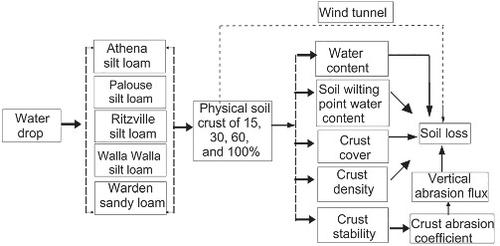当前位置:
X-MOL 学术
›
Earth Surf.Process. Land.
›
论文详情
Our official English website, www.x-mol.net, welcomes your
feedback! (Note: you will need to create a separate account there.)
Influence of physical crust cover on the wind erodibility of soils in the inland Pacific Northwest, USA
Earth Surface Processes and Landforms ( IF 2.8 ) Pub Date : 2021-03-10 , DOI: 10.1002/esp.5113 Huawei Pi 1, 2 , Nicholas P. Webb 3 , David R. Huggins 4 , Brenton Sharratt 4
Earth Surface Processes and Landforms ( IF 2.8 ) Pub Date : 2021-03-10 , DOI: 10.1002/esp.5113 Huawei Pi 1, 2 , Nicholas P. Webb 3 , David R. Huggins 4 , Brenton Sharratt 4
Affiliation

|
Soil crusts are especially important for agricultural fields in the inland Pacific Northwest where there is a high wind erosion risk due to exposure of fine erodible soils in fallow croplands. The objective of this study was therefore to evaluate the effect of physical soil crust cover on wind erosion and identify critical soil crust cover amounts to control wind erosion. The effect of crust cover of five loessial soils on wind erosion was tested in a wind tunnel. The results indicated that crust cover appeared to have little influence on soil loss until crust cover was > 30%. Soil loss at this percentage of crust cover was 55.04% to 68.08% lower as compared with a soil surface devoid of crust cover for the five soil types. The relationship between soil loss and crust cover appeared to be nearly a linear function, although an exponential function also provided a good fit to the data. With progressive development of a crust cover, the rate of change in soil loss varied among soil types. From 0 to 100% crust cover, the rate of change in soil loss ranged from −312.8 g m−2 for Palouse silt loam to −1449.1 g m−2 for Warden sandy loam. The rate was not only associated with intrinsic soil erodibility, but also crust stability and abrasion flux. Due to the lower intrinsic soil erodibility and greater crust stability, Palouse silt loam crust was characterized by lower flaking potential and limited abrasion flux relative to the other tested soil types. The Single-event Wind Erosion Evaluation Program (SWEEP) was used to simulate and identify the effect of crust cover on erosion processes. Differences between simulated and measured soil loss suggest that cracks in soil crusts may affect soil loss and should be incorporated into the SWEEP to expand the model capability for representing crusted soils.
中文翻译:

物理地壳覆盖对美国西北太平洋内陆土壤风蚀性的影响
土壤结皮对于太平洋西北部内陆的农田尤其重要,那里由于休耕地中易侵蚀土壤的暴露而存在很高的风蚀风险。因此,本研究的目的是评估物理土壤结皮覆盖对风蚀的影响,并确定控制风蚀的临界土壤结皮覆盖量。在风洞中测试了五种黄土的地壳覆盖对风蚀的影响。结果表明,在地壳覆盖> 30% 之前,地壳覆盖似乎对土壤流失几乎没有影响。与没有地壳覆盖的五种土壤类型的土壤表面相比,在这个地壳覆盖百分比下的土壤流失量要低 55.04% 至 68.08%。土壤流失和地壳覆盖之间的关系似乎是一个线性函数,尽管指数函数也很好地拟合了数据。随着地壳覆盖层的逐渐发展,土壤流失的变化率因土壤类型而异。从 0% 到 100% 地壳覆盖,土壤流失的变化率范围为 -312.8 g m-2为帕卢斯粉砂壤到-1449.1克米-2为看守砂壤土。该速率不仅与土壤内在可蚀性有关,而且与地壳稳定性和磨损通量有关。由于较低的土壤固有可蚀性和较大的地壳稳定性,Palouse 粉砂壤土地壳的特点是相对于其他测试的土壤类型具有较低的剥落潜力和有限的磨损通量。单事件风蚀评估程序 (SWEEP) 用于模拟和识别地壳覆盖对侵蚀过程的影响。模拟和测量土壤流失之间的差异表明土壤结皮中的裂缝可能会影响土壤流失,应将其纳入 SWEEP 以扩展代表结皮土壤的模型能力。
更新日期:2021-03-10
中文翻译:

物理地壳覆盖对美国西北太平洋内陆土壤风蚀性的影响
土壤结皮对于太平洋西北部内陆的农田尤其重要,那里由于休耕地中易侵蚀土壤的暴露而存在很高的风蚀风险。因此,本研究的目的是评估物理土壤结皮覆盖对风蚀的影响,并确定控制风蚀的临界土壤结皮覆盖量。在风洞中测试了五种黄土的地壳覆盖对风蚀的影响。结果表明,在地壳覆盖> 30% 之前,地壳覆盖似乎对土壤流失几乎没有影响。与没有地壳覆盖的五种土壤类型的土壤表面相比,在这个地壳覆盖百分比下的土壤流失量要低 55.04% 至 68.08%。土壤流失和地壳覆盖之间的关系似乎是一个线性函数,尽管指数函数也很好地拟合了数据。随着地壳覆盖层的逐渐发展,土壤流失的变化率因土壤类型而异。从 0% 到 100% 地壳覆盖,土壤流失的变化率范围为 -312.8 g m-2为帕卢斯粉砂壤到-1449.1克米-2为看守砂壤土。该速率不仅与土壤内在可蚀性有关,而且与地壳稳定性和磨损通量有关。由于较低的土壤固有可蚀性和较大的地壳稳定性,Palouse 粉砂壤土地壳的特点是相对于其他测试的土壤类型具有较低的剥落潜力和有限的磨损通量。单事件风蚀评估程序 (SWEEP) 用于模拟和识别地壳覆盖对侵蚀过程的影响。模拟和测量土壤流失之间的差异表明土壤结皮中的裂缝可能会影响土壤流失,应将其纳入 SWEEP 以扩展代表结皮土壤的模型能力。











































 京公网安备 11010802027423号
京公网安备 11010802027423号